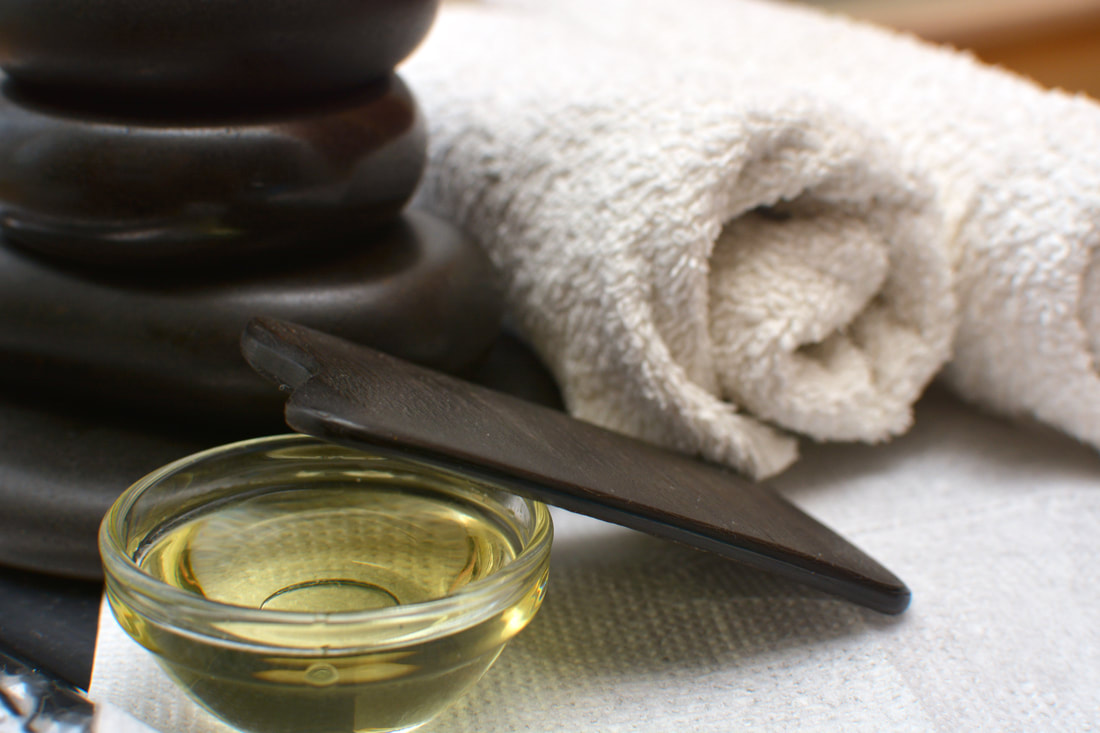Gua Sha (Scraping)
|
Gua Sha is said to date back 700 years and has been very popular in many ancient cultures including Vietnam, Korea, Japan, Indonesia, and India. It is also known as "Spooning" or "Coining" to English speakers, "Tribo-Effleurage" to the French and "Kerokan" to the Japanese.
In this procedure, a lubricating medium is applied to the area to be treated. A smooth-edged instrument is used to apply short or long strokes on the skin, typically in the area of pain or on the back. These strokes release myofascial tension and relieve muscles, fascia and connective tissues that are tight or stuck. During the treatment, you'll experience a warming sensation that is somehow both intense and relaxing at the same time. Afterwards, you'll notice that the stroking motion of the tool creates raised redness (petechiae) or bruising (ecchymosis) that will last for a couple of days or longer. |
Pain, both acute and chronic, is the most common indication for gua sha. The guiding principle behind gua sha is that this technique has the ability to break up stagnation, increasing blood flow (microcirculation) in the soft tissue as well as potentially stimulating the body’s natural pain-relieving opioid systems, which block the pain response pathways so you feel relief.
"Some view gua sha as folk medicine, but the scientific research community may beg to differ! Researchers from institutions like Harvard and Beth Israel Medical Center are demonstrating both efficacy as well as offering insight on why gua sha works. A study published in a 2011 edition of Pain Medicine demonstrated that gua sha decreased pain for chronic neck pain sufferers, noting that “neck pain severity after 1 week improved significantly better in the gua sha group compared with the control group (heat therapy).
Researchers have used various techniques, including Doppler images, to show that microcirculation is indeed increased in the treated area, therefore decreasing both local and distal areas of pain. In the mice model, gua sha was shown to influence an enzyme (Heme Oxygenase-1) that has a protective antioxidative effect in the cells. An interesting case study showed gua sha decreases inflammatory markers of a patient with liver injury due to Hepatitis B, suggesting gua sha may even have a protective effect on the liver. As is the case for most healing modalities in Eastern Medicine, modern science has yet again validated the effectiveness of this ancient technique." - 3/26/2012 | Scrape Away Pain: Gua Sha | Jamie Starkey, LAc | Oz Blog
"Some view gua sha as folk medicine, but the scientific research community may beg to differ! Researchers from institutions like Harvard and Beth Israel Medical Center are demonstrating both efficacy as well as offering insight on why gua sha works. A study published in a 2011 edition of Pain Medicine demonstrated that gua sha decreased pain for chronic neck pain sufferers, noting that “neck pain severity after 1 week improved significantly better in the gua sha group compared with the control group (heat therapy).
Researchers have used various techniques, including Doppler images, to show that microcirculation is indeed increased in the treated area, therefore decreasing both local and distal areas of pain. In the mice model, gua sha was shown to influence an enzyme (Heme Oxygenase-1) that has a protective antioxidative effect in the cells. An interesting case study showed gua sha decreases inflammatory markers of a patient with liver injury due to Hepatitis B, suggesting gua sha may even have a protective effect on the liver. As is the case for most healing modalities in Eastern Medicine, modern science has yet again validated the effectiveness of this ancient technique." - 3/26/2012 | Scrape Away Pain: Gua Sha | Jamie Starkey, LAc | Oz Blog
Copyright 2010-2023 - The Fusion Bodywork logo, forms & documents, as well as all therapist and studio images contained within this site are the copyright of Fusion Bodywork. Copying and other use, of any of these items, is not allowed. Trademark 2012-2023 - The term Fusion Therapy® is the registered trademark of Jennifer Jackson.
Insurance & Payment Information Non- Discrimination Policy Medical Disclaimer Privacy & Legal Statements
Insurance & Payment Information Non- Discrimination Policy Medical Disclaimer Privacy & Legal Statements


